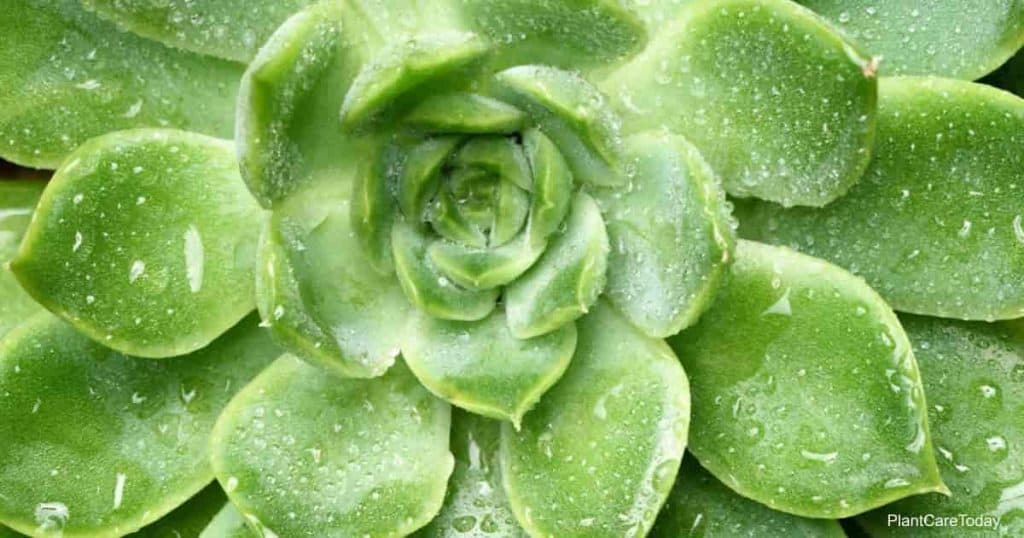The Echeveria Green Prince is a succulent plant from the Echeveria [ech-e-ver’-i-a] genus.
Echeverias are characterized by a fleshy rosette of colorful leaves. They belong to the Crassula family, also known as Crassulaceae.

Echeveria plants are native to warm, dry regions of Mexico and Central America.
Green Prince is a hybrid that can display wide variations in size and color.
This plant can be identified by its flat, fleshy green leaves. They’re usually a vivid green, though they can be lighter or darker in color based on the plant’s genetics.
Leaves are often tipped with a brownish-red coloration.
Plants are often small to medium in size, rarely reaching more than a few inches in height. While young plants tend to sit close to the ground, mature rosettes may sit on a thick, fleshy stalk.
As part of the Echeveria genus, the Green Prince is also known as “Mexican Hens and Chicks.” As a member of the Crassula family, Echeveria plants are more widely referred to as “stonecrops.”
NOTE: Most people in the United States pronounce the genus as [ech-e-ver’-i-a]. In other parts of the world, you may hear it pronounced as [ek-e-ve’-ri-a].
Echeveria Green Prince Plant Care
Size & Growth
As a desert plant, Echeveria tends to grow best in warm temperatures and with plenty of light. Green Prince plants tend to grow best in the summer, especially in USDA hardiness zone 9.
Plants grow relatively quickly and are easy to care for. Rosettes can reach up to around 6” in diameter in larger varieties.
The rosettes rest atop a fleshy stalk. Plants can reach higher than other succulents in the same family.
Flowering and Fragrance
The Prince flowers in the spring or summer. This is earlier than many other Echeveria varieties.
The plant sends out a stalk that can reach up to around 12” long, tipped with pink bell-shaped flowers. Typically, light intensity triggers blooming.
Lighting & Temperature
Echeveria green prince grows best when given plenty of exposure to light. But, they can also grow indoors as a houseplant.
This plant does best on a window sill with at least six to eight hours of full sun each day.
More light can cause brighter coloration in the leaves and blooms. But it can also cause sunburn and shriveling.
If you plan on moving your plant to an area with more sunlight, do so slowly and water them well to prevent damage.
Watering Needs and Feeding
Succulent plants handle drought conditions and need occasional watering to thrive. Too much, and you may risk giving your Green Prince root rot.
You may also want to give your plant a balanced cactus fertilizer as it grows. Avoid using fertilizer during the winter.
Details on How Often To Water Echeveria
Soil & Transplanting
Keep potting soil moist but not damp during the growing season. Adding plenty of rocks, sand, or Perlite or pumice can help to improve drainage.
When it comes time to transplant, use the same type of soil. Make sure to choose a pot that allows plenty of room for root growth and allows for drainage at the bottom. Do Not over pot.
Grooming and Maintenance
Echeveria Green Prince care is relatively easy, as these plants thrive even when neglected. It doesn’t need very much water or fertilizer to grow.
Stick to an appropriate care schedule and make sure the plant sits where it can get plenty of light.
How To Propagate Echeveria Green Prince
Propagate when the weather starts to warm, in spring or early summer.
Make sure that the plant is healthy and well-watered, with no signs of pests of rot.
- Pluck off leaves from the base
- Make sure to leave nothing on the stem that might cause an infection
- You can also remove offsets from the stem itself using a utility knife or razor blade
- Be careful not to damage the parent plant when doing so.
- When leaf cuttings or offshoots are ready, place it on some prepared potting mix.
- It is best to stick to either dry sand or a mixture of sand and soil
- Plants need superior drainage when dealing with succulents.
When repotting, it’s often a good time to think about propagating your Echeveria.
Collect older echeveria leaves that drop off and see if they’ll take root.
Keep in mind that dried or damaged leaves may not propagate as well as young, healthy ones.
Echeveria Green Prince Pests or Diseases
When it comes to Echeveria pests aren’t usually a big problem.
Give plants enough sunlight, water, and plenty of nutrients.
A healthy plant’s immune system should be able to fend off most bugs, diseases, and more.
Related: Details on Controlling Echeveria Pests and Diseases
Some pests pose more of a risk to your Echeveria than others.
Succulent mealybugs get into both the rosettes and the plant roots. Succulent aphids can damage the fleshy leaves.
When plants are weakened, look for signs of trouble, such as discoloration or wilting.
Even healthy plants can sometimes suffer from issues such as root rot.
Green Prince plants and other Echeveria species don’t need much in the way of moisture. It can be easy to accidentally overwater if you are not careful.
More On Echeveria Plants
Check out Echeveria Chroma for a colorful garden or windowsill addition. Our guide shares how to grow and care for this vibrant succulent.